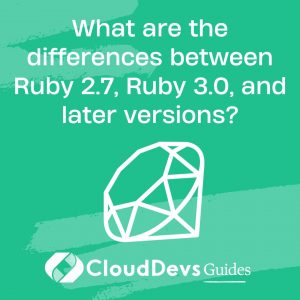What are the differences between Ruby 2.7, Ruby 3.0, and later versions?
Ruby has evolved over the years, with significant changes introduced in Ruby 2.7, Ruby 3.0, and subsequent versions. Here’s an overview of the key differences between these versions:
- Ruby 2.7:
– Pattern Matching: Ruby 2.7 introduced pattern matching, a powerful feature that simplifies conditional statements and provides more concise and readable code.
– Frozen String Literal Syntax: Ruby 2.7 introduced a new way to mark string literals as frozen with the `str.freeze` pragma, improving memory efficiency.
– Performance Improvements: Each Ruby version typically brings performance enhancements, and Ruby 2.7 was no exception. It included various optimizations, making Ruby code execution faster.
- Ruby 3.0:
– Fiber Scheduler: Ruby 3.0 introduced a Fiber Scheduler, improving concurrency and making it easier to write multithreaded applications.
– Ractors: Ractors (formerly known as Guilds) were introduced as an experimental feature for parallelism, allowing better utilization of multi-core CPUs.
– Performance: Ruby 3.0 continued to focus on performance improvements, making Ruby faster and more efficient.
– Error Handling: Ruby 3.0 introduced a new way of handling exceptions using `begin`/`rescue`/`else`/`ensure` in a more natural and intuitive way.
- Subsequent Versions (e.g., Ruby 3.1 and Beyond):
– Ruby continues to evolve with regular releases, introducing new features, optimizations, and bug fixes.
– Upcoming versions are expected to build upon the improvements introduced in Ruby 3.0 and may include enhancements in areas like performance, concurrency, and language features.
Overall, Ruby 2.7, Ruby 3.0, and later versions aim to enhance the language’s performance, concurrency support, and developer-friendliness. As you move to newer versions of Ruby, it’s essential to stay updated with the release notes and documentation to take advantage of the latest features and improvements while ensuring backward compatibility with your existing codebase.







